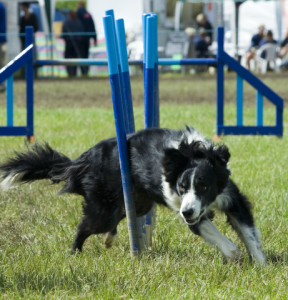As a dog owner and lover, when I hear the word “agility” I first think about dogs, and the obstacle courses they are trained to  navigate competitively. Then there’s a favorite video of a squirrel running an obstacle course to get nuts. These are fun examples of how animals change what they do and how they do it, to get what they are after, whether it’s to please Mom or to grab a meal. In each case, lots of complications appear that require immediate, effective action. Each time, the animals (dog at agility match and squirrel at feeder) need to access their memories for similar experiences and apply past learning to act on each glitch. I would bet that the agility these animals have developed benefits their lives even more than pleasing Mom or getting a bite to eat. What are your thoughts?
navigate competitively. Then there’s a favorite video of a squirrel running an obstacle course to get nuts. These are fun examples of how animals change what they do and how they do it, to get what they are after, whether it’s to please Mom or to grab a meal. In each case, lots of complications appear that require immediate, effective action. Each time, the animals (dog at agility match and squirrel at feeder) need to access their memories for similar experiences and apply past learning to act on each glitch. I would bet that the agility these animals have developed benefits their lives even more than pleasing Mom or getting a bite to eat. What are your thoughts?
Today’s work environment is an extension of the world, integrated with it and impacted by its constant change i.e. in the economy, technology, customer needs, and advances made in industry and by competitors. We are routinely faced with opportunities and problems that require adjustments in our approaches. In order to be successful, individuals need to be agile. And, in order to sustain competitive advantage, organizations must be agile.
What is agility? It’s much more than an attitude of openness and flexibility. It is a way of working day in and day out, and it employs a set of skills that can only remain honed through continuous practice. Agile people view change as normal, seeking and spotting improvement opportunities as a matter of routine. To stay with or ahead of the market, an organization, collectively, needs to build knowledge and skills to be able to read the environment and respond quickly and effectively to meet changing business needs. Bersin by Deloitte defined Agility as “…a person’s ability and passion to quickly study a new problem” and to apply his knowledge and prior learning to form a deep understanding before making a decision. “It is not, for example, the ability to “shoot from the hip.” Experience in itself does not guarantee learning; people must take time to reflect and find meaning in their work results, to understand what happened and why it happened. Lisa Haneberg’s article in ASTD made the following key point: “Agility is our capacity to be consistently adaptable without having to change. It is the efficiency with which we can respond to nonstop change.”
Agile leaders who are focused on the future can change the course of their organizations to find new success. For example, Robert Gavin, CEO of Motorola in the mid-1960′s, realized that the retail industry was changing due to Japan’s emerging presence. He strategized with his leaders to move Motorola away from retailing radios, televisions and stereos to focusing on integrated chips and wireless communication. By the 1990s Motorola had divested its former retail product lines and had become a dominating force in cellular communications.
We can intuitively understand why our leaders need to be agile and future focused. But what does it mean to build an agile organization? Does everyone need to focus on the future while they do the work of today?
Building an agile organization means building agility in individuals, teams and groups. To find meaning in their experience and results, people need to have a cornerstone made up of information about the company’s mid-range business strategy and in particular, the value proposition. This cornerstone provides a most important benchmark they can consider when people think about what they do and how they do it.
Lisa Haneberg’s article at ASTD.org, “Training for Agility: Building the Skills Employees Need to Zig and Zag” provides us with a sports analogy. Imagine a professional tennis player named Bjorn. What might be his value proposition? Perhaps it is to win the season. Haneberg wrote, “… In between tournaments, Bjorn practices dozens of shots with a variety of practice partners on hard, grass, and clay courts. Each tennis match is unique, but he will be better able to respond to each new challenge because he has trained himself to adapt quickly.”
To build our agility, we can train as Bjorn does to increase our abilities to respond to new situations without having to change.” Agile work approaches can be practiced day in and day out, enabled by an individual’s desire to improve his work product or process. This is different from Change Management, which is a process that we use to implement and manage change; while agile work practices require adjustments, change has broader scope.
The culture of an organization may need to be changed to make people more comfortable “hacking” their work methods. In organizations where hierarchy and standard procedures are emphasized, leaders will need to develop a strategy for agility, and to drive changes i.e. in the culture, policies and leadership practices to support people in using agile work procedures. In an organization where Agility is identified as a core competency, is part of the business strategy, and can fit within the culture, managers can lead by example and a learning/training organization can provide training that enables and fosters agile work practices. Training that includes exercises in the following areas can help develop agile work skills:
- Problem-solving techniques
- Collaboration and teamwork
- Submitting suggestions (i.e. for work procedures that are tightly controlled and/or have down-stream impact)
- Developing alternative approaches
- Diplomacy and tact in questioning others
- Agile work practices
- Developing adaptability to changes in work responsibilities
- Managing stress caused by change
- Self-awareness
- Understanding and relating to other people
- Conducting experiments
Leading by example, managers can introduce systematic approaches to agility such as:
- Routinely conducting project or production post-mortems as a team, to learn from successes and failures (with no finger-pointing)
- Regularly discussing (and recognizing) effective agile work practices and their specific benefits
Fostering and building agility effectively can provide a multitude of benefits to an organization. A few examples are that:
- Changes do not stress people because change is the norm in agile organizations.
- As people become more agile they can identify and act on more possibilities and this makes the organization more competitive.
- Performance results improve, as does customer satisfaction and employee engagement.
In today’s fast-paced, changing world, our ability to continuously learn and adapt will determine how well our organizations thrive, short and long term.
Are you interested in building your own agility? Your organization’s agility? Would you like us to write another article going into more detail? Or, would you like recommended reading? Let us know.
Latest posts by Rosanna Nadeau, PCLEC (see all)
- Is Quality Being Lost In Today’s Quest For Efficient Execution? - August 31, 2023
- What is HR’s Strategic Role? - August 24, 2023
- Agility: The Ability to Zig and Zag - August 23, 2023












